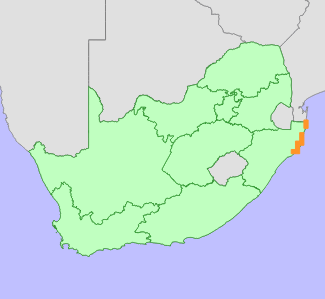|
Scientific Name | Restio zuluensis H.P.Linder |
Higher Classification | Monocotyledons |
Family | RESTIONACEAE |
National Status |
Status and Criteria | Vulnerable B1ab(iii)+2ab(iii) |
Assessment Date | 2007/09/11 |
Assessor(s) | L. von Staden & C.R. Scott-Shaw |
Justification | Restricted to a highly specialized habitat (AOO estimated <200 km²) and has a restricted range (EOO 2300 km²) in northern KwaZulu-Natal. There are nine known locations, and although much of the habitat is well protected within the extensive Greater St Lucia Wetland Park, there is continuing decline in the quality and extent of the habitat outside reserve areas. Subpopulations are large and the habitat is mostly intact within reserve systems, and therefore not considered severely fragmented. This species also occurs in southern Mozambique, but the extent of its range, its habitat and threats are not known. |
Distribution |
Endemism | Not endemic to South Africa |
Provincial distribution | KwaZulu-Natal |
Range | Northern KwaZulu-Natal and southern Mozambique. |
Habitat and Ecology |
Major system | Terrestrial |
Major habitats | Maputaland Wooded Grassland, Maputaland Coastal Belt |
Description | Grows on the margins of wetlands in short coastal grassland. |
Threats |
| Although Subtropical Freshwater Wetlands are only about 10% transformed according to NLC 1996, the surrounding coastal grasslands are between 40 and 50% transformed by commercial forestry plantations, subsistence agriculture and severe overgrazing and over-burning, which is having an ongoing impact on the quality of wetland habitats (C.R. Scott-Shaw pers. comm. 2007). This species has declined extensively in the past, especially in the southern end of the range between Richards Bay and St Lucia and is now mainly confined to reserves. |
Population |
Population trend | Decreasing |
Conservation |
| Protected in the Greater St. Lucia Wetland Park as well as the Nhlabane Nature Reserve near Richards Bay. |
Notes |
| The only species of Restio known from subtropical Africa. The rhizome is very atypical of the genus, so it may be a very isolated species (Linder 1985). |
Assessment History |
Taxon assessed |
Status and Criteria |
Citation/Red List version | | Restio zuluensis H.P.Linder | VU B1ab(iii)+2ab(iii) | Raimondo et al. (2009) | | Restio zuluensis H.P.Linder | Lower Risk - Near Threatened | Scott-Shaw (1999) | |
Bibliography |
Linder, H.P. 2011. The African Restionaceae: an Interactive Key identification and description system. Version 6. http://www.systbot.uzh.ch/Bestimmungsschluessel/Restionaceae_en.html. Downloaded.
Raimondo, D., von Staden, L., Foden, W., Victor, J.E., Helme, N.A., Turner, R.C., Kamundi, D.A. and Manyama, P.A. 2009. Red List of South African Plants. Strelitzia 25. South African National Biodiversity Institute, Pretoria.
Scott-Shaw, C.R. 1999. Rare and threatened plants of KwaZulu-Natal and neighbouring regions. KwaZulu-Natal Nature Conservation Service, Pietermaritzburg.
|
Citation |
| von Staden, L. & Scott-Shaw, C.R. 2007. Restio zuluensis H.P.Linder. National Assessment: Red List of South African Plants version 2024.1. Accessed on 2025/11/29 |
 Comment on this assessment
Comment on this assessment


